| In January 1948 the National Foundry College opened
in temporary accommodation at the Wolverhampton and
Staffordshire Technical College. |
| From Nature
Magazine, 22nd November, 1947:
The National Foundry College has
been established and its board of
governors nominated by the Minister
of Education. The College will be
housed in, and work closely in
conjunction with, the Wolverhampton
and Staffordshire Technical College.
The board of governors is charged
with the responsibility for
providing national facilities for
foundry education and research, in
the form of full-time courses,
vacation courses, refresher courses,
and the like, and also for providing
regional and local facilities for
full-time, part-time day and evening
courses, to cover the whole range of
foundry education.
Its first task will be the
re-establishment of the full-time
diploma course which was the main
feature of the predecessor of the
College, the British Foundry School,
during 1935-39. This course will
normally run for an academic year,
and the first session opens on
January 5th. The course will cover
the whole of the foundry industry,
ferrous and non-ferrous, including
grey, white and chilled iron
castings, malleable castings, steel
castings, and castings in
non-ferrous metals, such as alloys
of copper, tin, nickel, aluminium
and magnesium. The diploma awarded
to successful students will be
endorsed by the Ministry of
Education.
There is no upper age limit for
admission; a minimum of one year's
practical experience in at least one
branch of the industry will be
required, together with a Higher
National Certificate or a university
degree, preferably in metallurgy or
engineering, or a grade of
membership obtained by examination
of a professional institution in
engineering, metallurgy or
chemistry. Mr. J. Bamford, who was
in charge of the British Foundry
School during 1935-39, and who has
since held important managerial
appointments in the industry, has
been appointed head of the National
Foundry College. |
|
|

James Bamford, head of the
college. |
The British Foundry School had
been formed at Birmingham Central Technical College,
purely on a temporary basis in the mid 1930s.
The
Chairman, Randall Garfield Hoskings, C.B.E. was
assisted by Dr. W. E. Fisher, O.B.E., Principal of
the Wolverhampton and Staffordshire Technical
College.
After the war the college moved to the
Wolverhampton site, where a post-graduate diploma
course began and research was carried out.
The head
of the Foundry College was James Bamford. His
assistants were J. B. McIntyre, W. Prentice, S. N.
Wrightson and W. B. Hendry.
|
|

Casting gun metal. |
|

Heat treatment of alloys. |
| Within a few years the Foundry
College was to move into the new 3 storey building
in Stafford Street, that was built at a
cost of £90,000, plus £35,000 for equipment. In
January, 1953 the college governors made an appeal
to industry to provide £10,000 to equip the
experimental foundry, which resulted in donations
and equipment with a value of more than £7,000. |
|
The new building included a
fully-equipped foundry, two spacious teaching rooms,
equipped with visual aids, for use as either lecture
rooms or drawing offices, dark rooms, offices and
stores, seven laboratories, fitted with the most
up-to-date equipment for the chemical analysis, heat
treatment and metallographic examination of all
ferrous and non-ferrous materials. There was also a
workshop for maintenance work, the making of
research equipment and the preparation of test
pieces and specimens.
The foundry was used for the
teaching of foundry techniques and experimental
methods. There were also analytical and sand testing
facilities in adjacent laboratories, an X-ray room,
complete with a control room and a 250 kV, X-ray
machine, which was situated in the basement, along
with demonstration and dark rooms. The Metallurgical
Analysis Laboratory was in room 61 in an adjacent
building. Students of the foundry college and the
technical college had use of relevant laboratories
within the two colleges, including the pattern shop,
mechanical testing laboratory and the metallurgical
laboratories.
|

The new building in Stafford
Street and its main entrance. |
|

The college buildings in about
1953. The new foundry college is on the extreme
right. |
|

Metallurgical Analysis
Laboratory. |
|
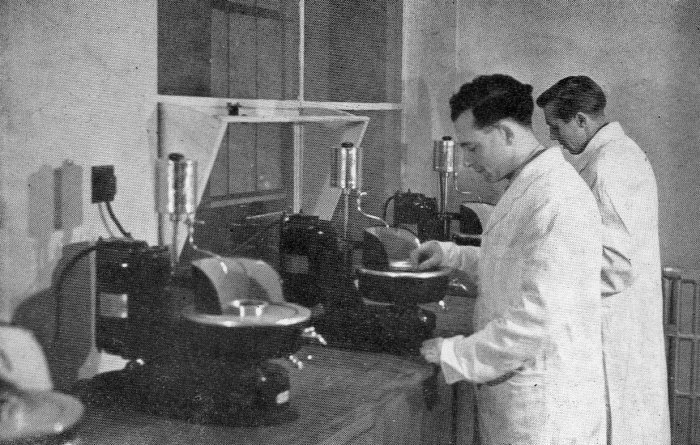
The preparation of
metallurgical specimens. |
|
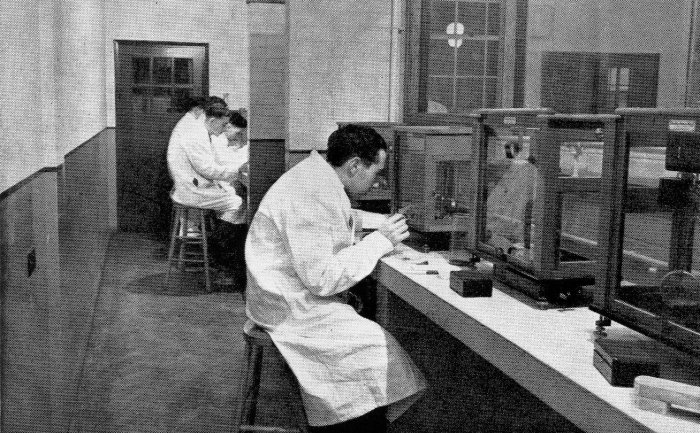
Balance Room. |
|
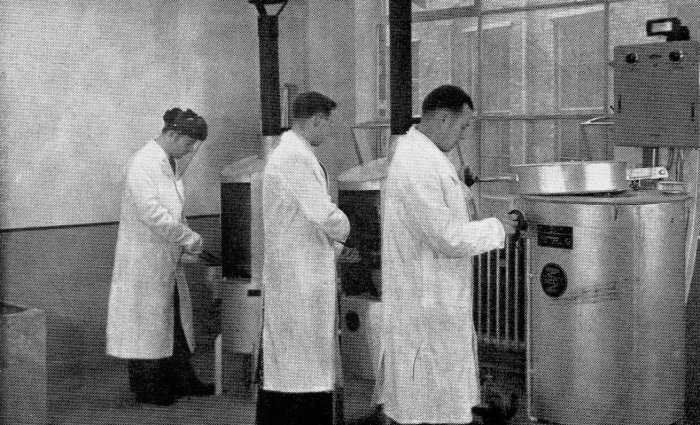
Heat Treatment Laboratory. |
|

Sand Testing. |
|
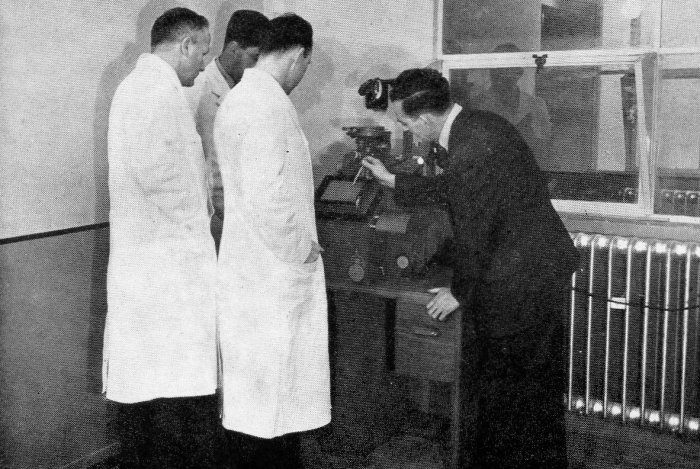
Metallography Tutorial. |
|

The Workshop. |
|
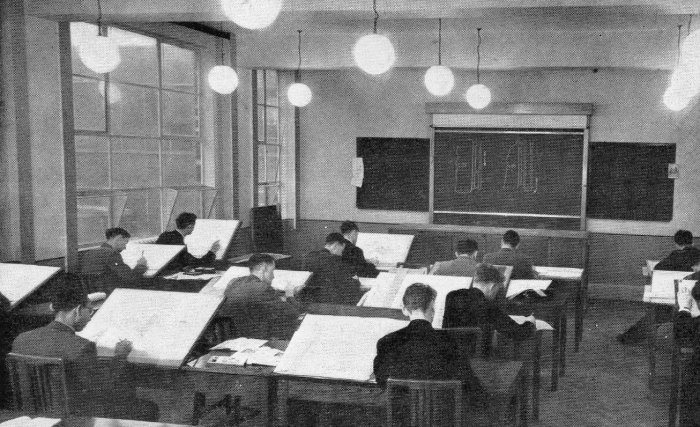
The Project Laboratory. |
| The foundry college ran
full-time and part-time courses and provided local
and regional education for the industry. The courses
listed in the prospectus included a Diploma Course,
Post-Diploma work, short courses and local
activities. Also listed are the necessary
qualifications for entry and the arrangements under
which entrance, progress and research scholarships
were awarded, together with several benefits
that were included within the scholarship award.
Students during their course were expected to reside
in Tor Lodge Hostel, at Tettenhall, unless given
special permission to live elsewhere. |
|

Tor Lodge. |
|
Tor Lodge Hostel was officially opened on 23rd September 1949 by
Mr. George Tomlinson, Minister of Education, who also visited
the National Foundry College and inaugurated its third session.
Tor Lodge is situated near to the Mount Hotel in Mount Road,
Tettenhall and could accommodate up to 30 students. It was
looked after by Mrs. Quigley who lived in the cottage by the
entrance to Tor Lodge Drive.
Near to Tor Lodge, off Tor Lodge Drive, Tettenhall, is
Applecross, another house that was used for residential
accommodation for foundry college students, many of whom were
from abroad. Both houses were sold and provided funds for the Tor Lodge and Applecross Trust, a charity that supports people
who work in the cast metals industry, by offering contributions
towards the cost of training and education.
|
|
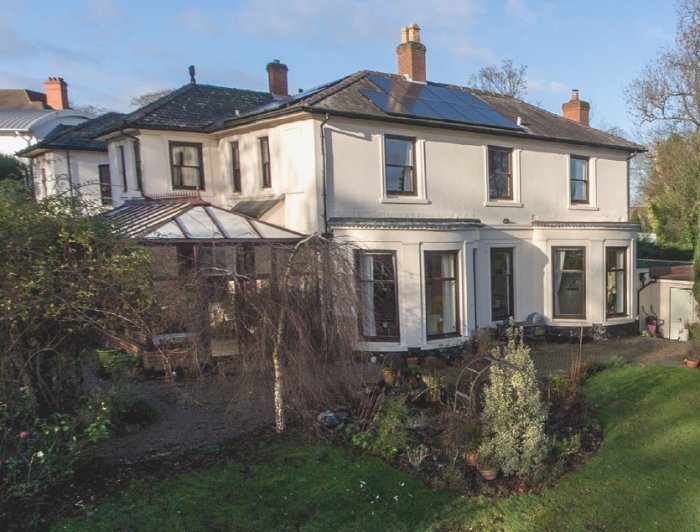
Tor Lodge, as it is today. |
|

Applecross. Courtesy
of David Parsons and Mark Cooper. |
|

The students'
residential study room in Tor Lodge. |
|

The students'
residential lounge, also in Tor Lodge. |
|
The new buildings in Stafford
Street were completed in 1953. They were officially
opened on Wednesday 3rd February, 1954 by Sir
Gilbert Flemming, K.C.B. at a ceremony in the main
hall. |
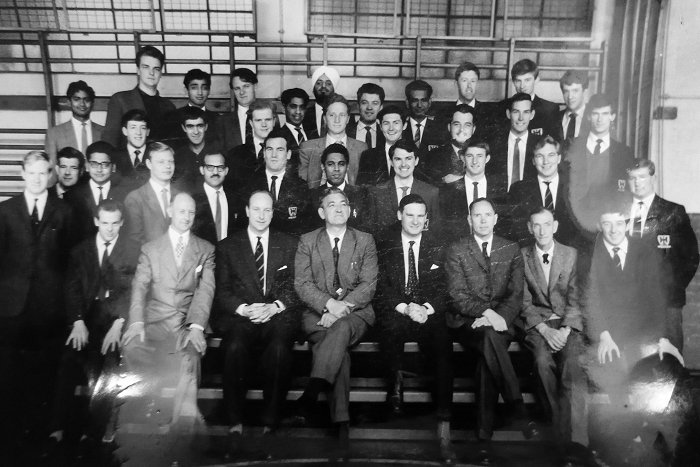
A photograph from the
early 1960s showing a new intake of students
and members of staff. Courtesy of David
Parsons and Mark Cooper. |

A group of students and
staff from the National Foundry College, during
an end of year trip to Italy in 1965. It was
their final year at the college. They visited
several Italian foundries and engineering
companies including the Lamborghini car company
in Modena. The photo is courtesy of David
Parsons and Mark Cooper, who is on the far
right. |
|
The Foundry College closed in August 1967. In 1966 the government ceased to
support such institutions. The government grant was removed and
changes were made to further education and the way students were
trained to enter industry. Tor Lodge Hostel was sold and became
accommodation for students who studied pattern making,
foundry work or photography at Wednesbury College and West
Bromwich College of Commerce and Technology. The house was sold
in 1988 and is now a private residence.
I have to thank David Parsons and Mark Cooper for the photographs used in this
section. |
 |
|
 |
|
 |
Return to
Technical College |
|
Return to
the contents |
|
Proceed to
Day Courses |
|